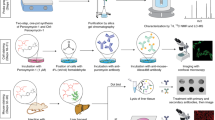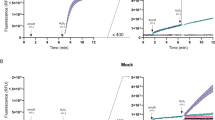Abstract
Hydrogen peroxide (H2O2) is emerging as a newly recognized messenger in cellular signal transduction1,2. However, a substantial challenge in elucidating its diverse roles in complex biological environments is the lack of methods for probing this reactive oxygen metabolite in living systems with molecular specificity. Here we report the synthesis and application of Peroxy Green 1 (PG1) and Peroxy Crimson 1 (PC1), two new fluorescent probes that show high selectivity for H2O2 and are capable of visualizing endogenous H2O2 produced in living cells by growth factor stimulation, including the first direct imaging of peroxide produced for brain cell signaling. The combined features of reactive oxygen species selectivity, sensitivity to signaling levels of H2O2, and live-cell compatibility presage many new opportunities for PG1, PC1 and related synthetic reagents for exploring the physiological roles of H2O2 in living systems with molecular imaging.
*Note: In the version of this article initially published, the second author's last name is misspelled. The author's name should read Orapim Tulyathan. The error has been corrected in the HTML and PDF versions of the article.
This is a preview of subscription content, access via your institution
Access options
Subscribe to this journal
Receive 12 print issues and online access
$259.00 per year
only $21.58 per issue
Buy this article
- Purchase on Springer Link
- Instant access to full article PDF
Prices may be subject to local taxes which are calculated during checkout




Similar content being viewed by others
Change history
03 May 2007
changed from Tulyanthan to Tulyathan, first n removed
References
Rhee, S.G. H2O2, a necessary evil for cell signaling. Science 312, 1882–1883 (2006).
Finkel, T. Oxidant signals and oxidative stress. Curr. Opin. Cell Biol. 15, 247–254 (2003).
Beckman, K.B. & Ames, B.N. The free radical theory of aging matures. Physiol. Rev. 78, 547–581 (1998).
Stone, J.R. & Yang, S. Hydrogen peroxide: a signaling messenger. Antioxid. Redox Signal. 8, 243–270 (2006).
Sundaresan, M., Yu, Z.-X., Ferrans, V.J., Irani, K. & Finkel, T. Requirement for generation of H2O2 for platelet-derived growth factor signal transduction. Science 270, 296–299 (1995).
Bae, Y.S. et al. Epidermal growth factor (EGF)-induced generation of hydrogen peroxide. Role in EGF receptor-mediated tyrosine phosphorylation. J. Biol. Chem. 272, 217–221 (1997).
Ohba, M., Shibanuma, M., Kuroki, T. & Nose, K. Production of hydrogen peroxide by transforming growth factor-β1 and its involvement in induction of egr-1 in mouse osteoblastic cells. J. Cell Biol. 126, 1079–1088 (1994).
Kimura, T., Okajima, F., Sho, K., Kobayashi, I. & Kondo, Y. Thyrotropin-induced hydrogen peroxide production in FRTL-5 thyroid cells is mediated not by adenosine 3′,5′-monophosphate, but by Ca2+ signaling followed by phospholipase-A2 activation and potentiated by an adenosine derivative. Endocrinology 136, 116–123 (1995).
Mukhin, Y.V. et al. 5-Hydroxytryptamine1A receptor/Gibetagamma stimulates mitogen-activated protein kinase via NAD(P)H oxidase and reactive oxygen species upstream of src in chinese hamster ovary fibroblasts. Biochem. J. 347, 61–67 (2000).
Lee, S.R., Kwon, K.S., Kim, S.R. & Rhee, S.G. Reversible inactivation of protein-tyrosine phosphatase 1B in A431 cells stimulated with epidermal growth factor. J. Biol. Chem. 273, 15366–15372 (1998).
Salmeen, A. et al. Redox regulation of protein tyrosine phosphatase 1B involves a sulphenyl-amide intermediate. Nature 423, 769–773 (2003).
Guyton, K.Z., Liu, Y., Gorospe, M., Xu, Q. & Holbrook, N.J. Activation of mitogen-activated protein kinase by H2O2. Role in cell survival following oxidant injury. J. Biol. Chem. 271, 4138–4142 (1996).
Schmidt, K.N., Amstad, P., Cerutti, P. & Baeuerle, P.A. The roles of hydrogen peroxide and superoxide as messengers in the activation of transcription factor NF-κB. Chem. Biol. 2, 13–22 (1995).
Avshalumov, M.V. & Rice, M.E. Activation of ATP-sensitive K+ (K(ATP)) channels by H2O2 underlies glutamate-dependent inhibition of striatal dopamine release. Proc. Natl. Acad. Sci. USA 100, 11729–11734 (2003).
Wood, Z.A., Poole, L.B. & Karplus, P.A. Peroxiredoxin evolution and the regulation of hydrogen peroxide signaling. Science 300, 650–653 (2003).
Woo, H.A. et al. Reversing the inactivation of peroxiredoxins caused by cysteine sulfinic acid formation. Science 300, 653–656 (2003).
Biteau, B., Labarre, J. & Toledano, M.B. ATP-dependent reduction of cysteine-sulphinic acid by S. cerevisiae sulphiredoxin. Nature 425, 980–984 (2003).
Lee, J.-W. & Helmann, J.D. The PerR transcription factor senses H2O2 by metal-catalysed histidine oxidation. Nature 440, 363–367 (2006).
Stadtman, E.R., Van Remmen, H., Richardson, A., Wehr, N.B. & Levine, R.L. Methionine oxidation and aging. Biochim. Biophys. Acta 1703, 135–140 (2005).
Soh, N. Recent advances in fluorescent probes for the detection of reactive oxygen species. Anal. Bioanal. Chem. 386, 532–543 (2006).
Hempel, S.L., Buettner, G.R., O'Malley, Y.Q., Wessels, D.A. & Flaherty, D.M. Dihydrofluorescein diacetate is superior for detecting intracellular oxidants: comparison with 2′,7′-dichlorodihydrofluorescein diacetate, 5(and 6)-carboxy-2′,7′-dichlorodihydrofluorescein diacetate, and dihydrorhodamine 123. Free Radic. Biol. Med. 27, 146–159 (1999).
Zhou, M., Diwu, Z., Panchuk-Voloshina, N. & Haugland, R.P. A stable nonfluorescent derivative of resorufin for the fluorometric determination of trace hydrogen peroxide: applications in detecting the activity of phagocyte NADPH oxidase and other oxidases. Anal. Biochem. 253, 162–168 (1997).
Maeda, H. et al. Fluorescent probes for hydrogen peroxide based on a non-oxidative mechanism. Angew. Chem. Int. Ed. 43, 2389–2391 (2004).
Belousov, V.V. et al. Genetically encoded fluorescent indicator for intracellular hydrogen peroxide. Nat. Methods 3, 281–286 (2006).
Chang, M.C., Pralle, A., Isacoff, E.Y. & Chang, C.J. A selective, cell-permeable optical probe for hydrogen peroxide in living cells. J. Am. Chem. Soc. 126, 15392–15393 (2004).
Miller, E.W., Albers, A.E., Pralle, A., Isacoff, E.Y. & Chang, C.J. Boronate-based fluorescent probes for imaging cellular hydrogen peroxide. J. Am. Chem. Soc. 127, 16652–16659 (2005).
Setsukinai, K.-I., Urano, Y., Kakinuma, K., Majima, H.J. & Nagano, T. Development of novel fluorescence probes that can reliably detect reactive oxygen species and distinguish specific species. J. Biol. Chem. 278, 3170–3175 (2003).
Ullrich, A. et al. Human epidermal growth factor receptor cDNA sequence and aberrant expression of the amplified gene in A431 epidermoid carcinoma cells. Nature 309, 418–425 (1984).
Wong, R.W.C. & Guillaud, L. The role of epidermal growth factor and its receptors in mammalian CNS. Cytokine Growth Factor Rev. 15, 147–156 (2004).
Acknowledgements
We thank the University of California, Berkeley, the Dreyfus Foundation, the Beckman Foundation, the American Federation for Aging Research, the Packard Foundation, and the US National Institute of General Medical Sciences (NIH GM 79465) for funding this work. E.W.M. thanks the Chemical Biology Graduate Program sponsored by the US National Institutes of Health (T32 GM066698) and a Stauffer fellowship for support. We thank D. Fortin and S. Szobota for providing neuronal cultures, and we thank K. McNeill (University of Minnesota) for the polymer-supported Rose Bengal. Confocal fluorescence images were acquired at the Molecular Imaging Center at UC Berkeley. We also thank A. Fischer at the UC Berkeley Tissue Culture Facility for expert technical assistance.
Author information
Authors and Affiliations
Contributions
E.W.M. performed all of the synthetic and imaging experiments. O.T. prepared the neuronal cultures and helped with the immunostaining experiments. C.J.C. and E.W.M. designed experimental strategies with help from E.Y.I. C.J.C. and E.W.M. wrote the paper.
Corresponding author
Ethics declarations
Competing interests
The authors declare no competing financial interests.
Supplementary information
Supplementary Fig. 1
Spectroscopic responses and selectivities for PG1 and PC1 in different buffers. (PDF 107 kb)
Supplementary Fig. 2
Relative responses of PG1, PC1 or DCFH to H2O2 or high-valent iron-oxo centers generated from heme and H2O2. (PDF 239 kb)
Rights and permissions
About this article
Cite this article
Miller, E., Tulyathan, O., Isacoff, E. et al. Molecular imaging of hydrogen peroxide produced for cell signaling. Nat Chem Biol 3, 263–267 (2007). https://doi.org/10.1038/nchembio871
Received:
Accepted:
Published:
Issue Date:
DOI: https://doi.org/10.1038/nchembio871
This article is cited by
-
Proteomic analysis of exosomes secreted during the epithelial-mesenchymal transition and potential biomarkers of mesenchymal high-grade serous ovarian carcinoma
Journal of Ovarian Research (2023)
-
Boronates as hydrogen peroxide–reactive warheads in the design of detection probes, prodrugs, and nanomedicines used in tumors and other diseases
Drug Delivery and Translational Research (2023)
-
A puromycin-dependent activity-based sensing probe for histochemical staining of hydrogen peroxide in cells and animal tissues
Nature Protocols (2022)
-
Comprehensive analysis of epigenetics regulation, prognostic and the correlation with immune infiltrates of GPX7 in adult gliomas
Scientific Reports (2022)
-
Guidelines for measuring reactive oxygen species and oxidative damage in cells and in vivo
Nature Metabolism (2022)



